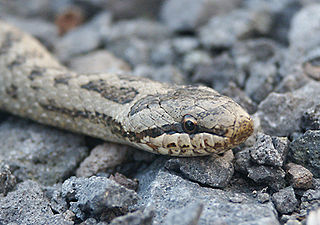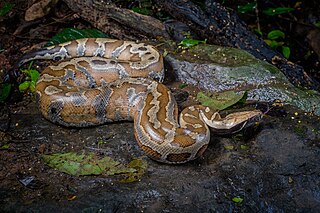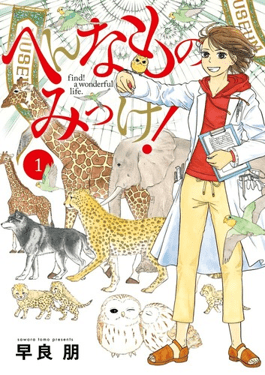
The smooth snake is a species of non-venomous snake in the family Colubridae. The species is found in northern and central Europe, but also as far east as northern Iran. The Reptile Database recognizes two subspecies as being valid, including the nominotypical subspecies described here.

Indotyphlops braminus, commonly known as the brahminy blind snake and other names, is a non-venomous blind snake species found mostly in Africa and Asia, but has been introduced in many other parts of the world. They are completely fossorial reptiles, with habits and appearance similar to earthworms, for which they are often mistaken, although close examination reveals tiny scales and eyes rather than the annular segments characteristic of true earthworms. The species is parthenogenetic and all known specimens have been female. The specific name is a Latinized form of the word Brahmin. No subspecies are currently recognized.

The long-nosed snake is a species of nonvenomous snake in the family Colubridae. The species is endemic to North America. It has two recognized subspecies. The other species in the genus were previously considered subspecies.

The eastern hog-nosed snake, is a species of mildly venomous rear-fanged snake in the family Colubridae. The species is endemic to North America. There are no subspecies that are recognized as being valid.

Storeria dekayi, commonly known as De Kay's brown snake, De Kay's snake, and simply the brown snake, is a small non-venomous species of snake in the family Colubridae. The species is native to North America and Central America.

Montivipera raddei or Armenian viper is a species of viper, a venomous snake in the subfamily Viperinae of the family Viperidae. The species is endemic to Armenia, Azerbaijan, Iran, Turkey, and possibly also Iraq. Two subspecies are recognized.

Drymobius margaritiferus, commonly known as the speckled racer, is a species of nonvenomous colubrid snake native to the Americas. The specific name, margaritiferus, means "pearl-bearing" in Latin, referring to the pearl-like spots on the dorsal scales.

Ijima's leaf warbler is a species of Old World warbler in the family Phylloscopidae. The species is native to Japan, where it has been designated a Natural Monument under the 1950 Law for the Protection of Cultural Properties, with records also from Taiwan and the Philippines.
Erythrolamprus ornatus, also known commonly as the ornate ground snake and the Saint Lucia racer, is a species of snake in the family Colubridae. The species is native to the eastern Caribbean. It is the rarest snake on earth with fewer than 20 left in the wild.

The Sakishima green snake is a species of snake in the family Colubridae. The species is endemic to the Yaeyama Islands in the southern Ryukyu Islands of Japan.

Python brongersmai is a species of nonvenomous snake in the family Pythonidae. The species is native to Southeast Asia.
The rim rock crowned snake, named after the Miami Rim Rock land arrangement, is a non-venomous endangered species of snake belonging to the family Colubridae. The rim rock crowned snake is endemic to the United States throughout southern Florida. The specific name, oolitica, refers to the oolitic limestone area of Florida in which the species is found. All species of snakes that belong to the genus Tantilla, are relatively small and usually do not exceed 20 cm (8 in). The species T. oolitica was added to the IUCN Red List in 2007 as a result of loss in habitat and restricted range.
Enteroplax is a genus of air-breathing land snails, terrestrial pulmonate gastropod mollusks in the family Strobilopsidae.

Diploderma polygonatum, also known as Ryukyu japalure and Okinawa tree lizard, is a species of lizard found in the Ryukyu Islands and Taiwan. It is diurnal and arboreal. An adult male Diploderma polygonatum measures "61 mm. from snout to vent, and 152 mm. from vent to tip of tail; total length 213 mm." The splenial of this lizard is short, as is that of Trapelus agilis. The lizard is also closely related to Diploderma swinhonis.

Hebius is a genus of snakes in the family Colubridae.

The JapaneseRed List is the Japanese domestic counterpart to the IUCN Red List of Threatened Species. The national Red List is compiled and maintained by the Ministry of the Environment, alongside a separate Red List for marine organisms. Similarly drawing on the relevant scientific authorities, NGOs, and local governments, the Ministry of the Environment also prepares and publishes a Red Data Book that provides further information on species and habitats.

Hen na Mono Mikke! is a Japanese manga series written and illustrated by Tomo Sawara. It has been serialized in Shogakukan's seinen manga magazine Monthly Big Comic Spirits since September 2016.

The Miyako toad is a subspecies of the Asiatic toad that is native to the Miyako Islands, in the Ryūkyū Islands of Japan.















